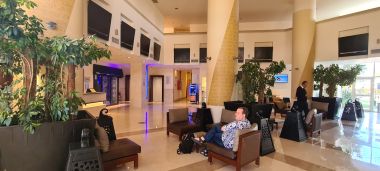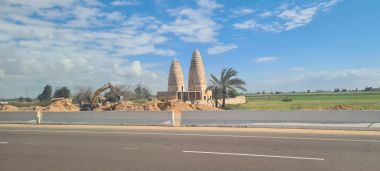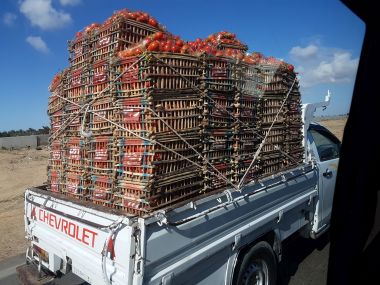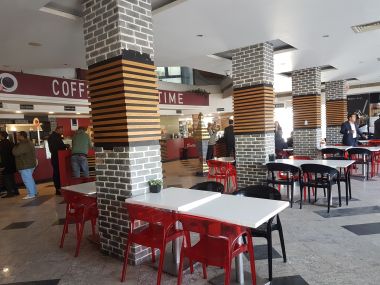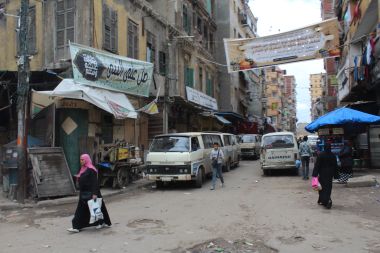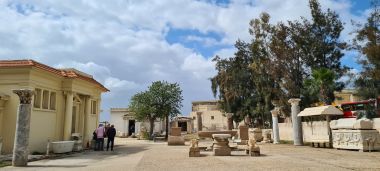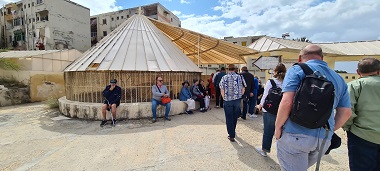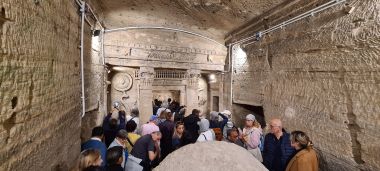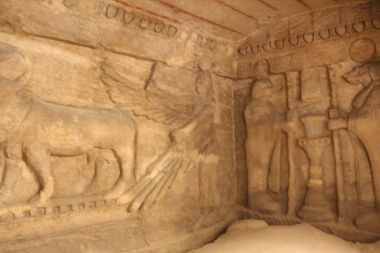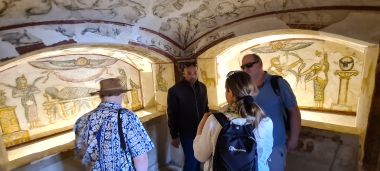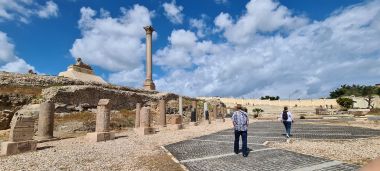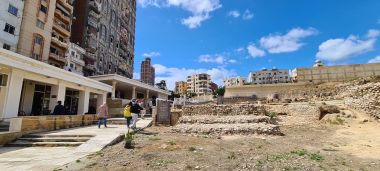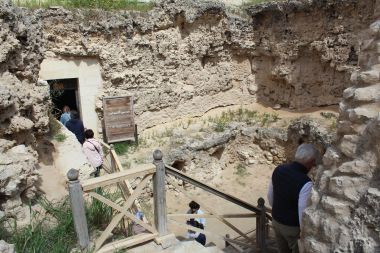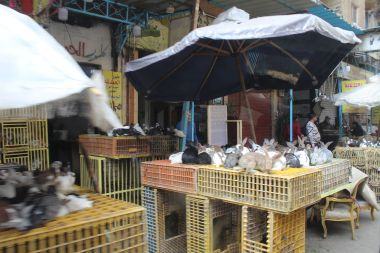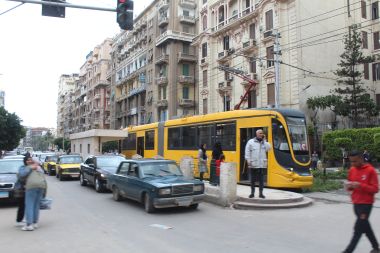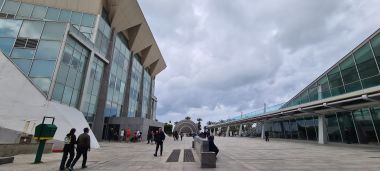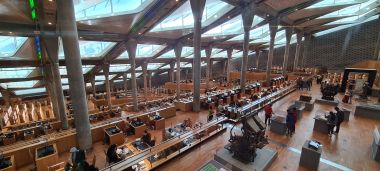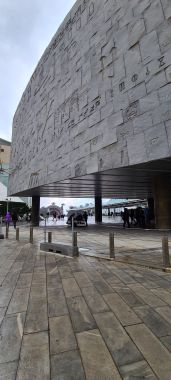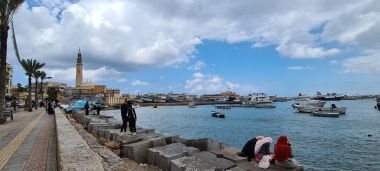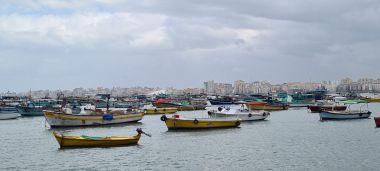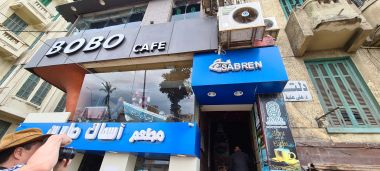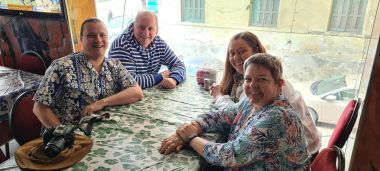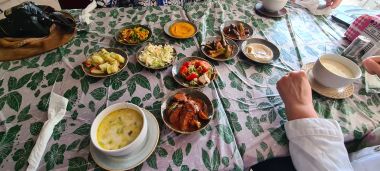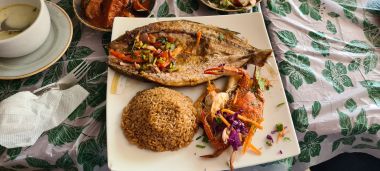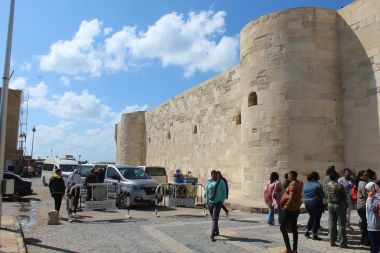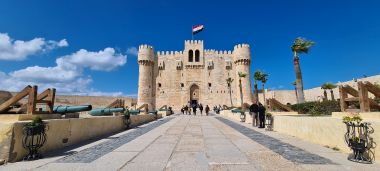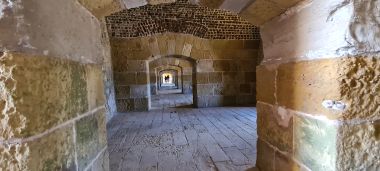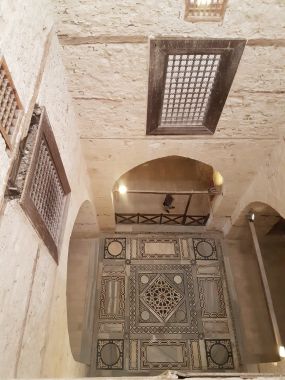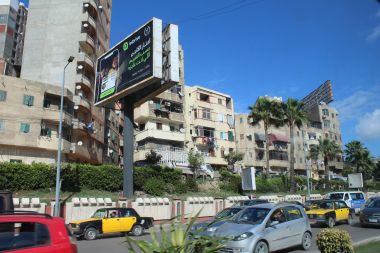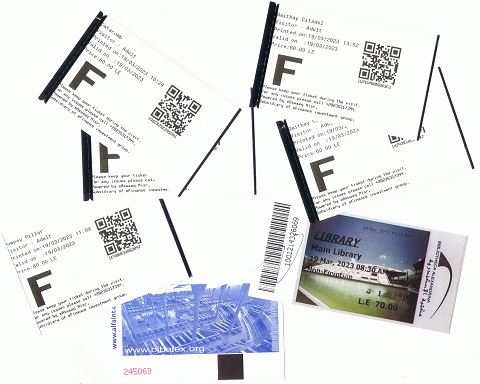Day 11 - Alexandria - March 19, 2023
An interesting final day of travel here in Egypt. Most will likely know of Alexandria as being the ancient home of the famous “Library of Alexandria” that was famously famously, if not apocryphally, burned in 48 BC, or perhaps the “Lighthouse of Alexandria” (“Pharos of Alexandria”) in the harbour. Today it is a busy, bustling city with a modern day “Library of Alexandria” that we were lucky enough to visit. But first, we had to get there from Cairo.
Our pick up from the hotel was at 7:15 am which was a bit of a relief though it did mean getting up at 6 am so we could have something to eat. It is about 200 km to Alexandria along highway 75 but we felt like we were in a Grand Prix as our driver, who we knick-named “Michael Andretti”, wove in and out of traffic throughout. Over taking, under taking, straddling lines…Despite the speed limit being 120 km/hr I regularly observed him doing 160 but often simply 130 or 140. It certainly woke us up and somewhat distracted from the lack of any amount of scenery which was flat, farmer's fields, though we did pass by an enormous prison. There were interesting pairs of tall domes on the side of the road that were were told were “dovecotes”, that is, they housed pigeons for eating.
Of course we were also interested in what was piled high in vehicles passing us which included trucks carrying tomatoes, sugar cane, and sugar beet.
In the passing fields we saw orange orchards and we were told even grapes are grown here. This is a major road linking the two most populous cities in the country so was well maintained and we even had to pass through a toll.
There are service stations along the way that are more laid-back expensive easy dining affairs. We stopped at one to use the toilets which were, as might be predicted, at the far end of the building necessitating having to first pass by all of the shops. Waiting for the rest of the group I wandered around to have a look through the windows at a shop selling music and movies, most of which looked to be illegal copies with brightly coloured labels in Arabic, and opposite was a shop selling souvenirs and clothing. There was a small convenience store here (with only two aisles) carrying familiar soft drinks, crisps/chips and other ephemera. On the dining and drinking side there was a small sit down restaurant near the shops but at the main entrance was a large coffee shop and patisserie. There was a large seating area off the car park at the front entrance as you really don't want to be inside with the number of people wandering around. After refreshing herself, Mel stood at the counter to order a coffee but was ignored for quite some time, as a woman, before eventually being served. It was a nice coffee, I am told.
Approaching Alexandria we were all of a sudden surrounded by water and, of course, industrial complexes including several refineries before entering the city proper. Lots of apartment blocks on the outskirts but not a lot of high buildings in the middle of the city. Alexandria at just over 5 million in 2018 (a lot more now, likely) is the largest city on the Mediterranean and second in population to only Cairo in Egypt. This is a much more urban affair than Cairo with attractions that somewhat pale in comparison to the pyramids or the Egyptian Museum. Yes, there were McDonalds aplenty along the highway as we entered the city.
Taking a side road we were suddenly in the older part of Alexandria with narrow streets lined with street stalls selling fresh fruit and vegetables. Horse cars carried produce around but otherwise the streets were awash with taxis, cars, tuk-tuks and scooters. A shout from Ahmed alerted us to an old street car passing in front of our minibus painted in green and beige with rounded windows. Evidently these are now quite rare to see though later we would see a much more modern version in the heart of the city.
We eventually arrived at Catacombs of Kom el Shoqafa, hidden in a back street somewhere and surrounding by housing. Pulling into the small car park we passed through the front gates and into the site which was quite underwhelming. Not a lot of people that we could see and the small space was lined with elaborately carved pieces of stone - Columns, and sarcophagi - Along with several small pillared buildings and a couple of trees.
Ahmed took us to the far end of the site where there was a round glass building where we saw much more people, all queuing to enter the building. This is the top of a spiral staircase that descends into what the tourists were all here to see - The Catacombs.
The spiral staircase consisted of shallow stone steps that were quite slippery with the light sand on their surface and a bit treacherous. In the middle of the staircase was a shaft all the way to the bottom, about 100 feet in height.
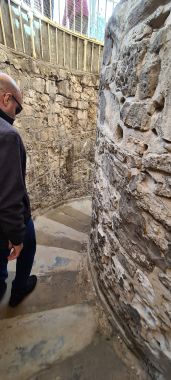
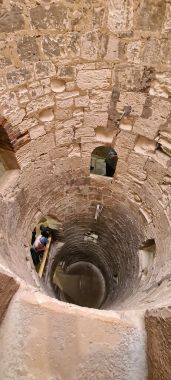
At the bottom we were confronted with a huge number of tour groups being shown around the small spaces.
Ahmed took us down a set of steps to the main tomb chamber containing three elaborately carved sarcophagi. The carvings are quite different to what we have been seeing, a cross between Egyptian, Greek and Roman which reflects the time in which they were built, in the second century, quite young as far as historical sites go in Egypt and the people that built them, an Alexandrian Pharaonic funerary cult. We waited quite some time before being able to enter the main tomb with deep carvings of rites and people but no writing. This is the most decorated room in the catacombs.
Moving on we were shown rooms with low ceilings full of long rectangular holes we were told housed the bodies of soldiers and in another room we saw the remains of the horses in a glass display case which were buried here as well. As might be expected, the rooms are arranged haphazardly and at different levels, carved painfully out of the sandstone with only the very occasional simple painting on the wall. It is not a massive site but quite interesting.
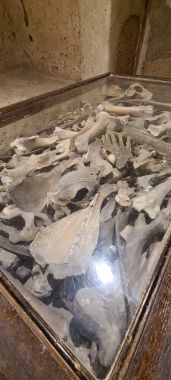
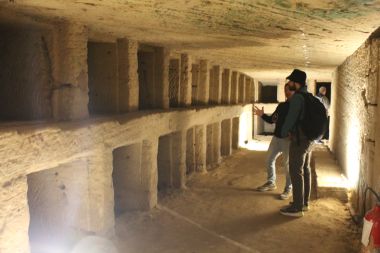
Returning up the staircase now slightly more impressed, we took in what we saw around us. I was busy admiring a rather large cactus growing off to the side in some ruins. We headed over to one of the small buildings nearer to the entrance which is a temple with two small headless sphinxes on either side of the entrance. Inside were brightly painted walls and arches again with the odd mix of Egyptian and European styles showing the fascinating the builders had with ancient Egypt.
Catacombs of Kom el Shoqafa Pictures (from Flickr)
Next we returned to the narrow streets of the old city and after a few minutes pulled up outside the walls of our next stop: Serapeum of Alexandria. After passing through the ticket barriers we found ourselves in a large rectangular space with a rocky mound in the middle of it topped with a tall column and flanked by two large sphinxes.
To our left there were the facilities including a gift shop and toilet with long steps leading up to the path that follows the wall around the site.
Beside the path was a large area full of archaeological pieces of carved rock arranged evenly on the ground. To our right we followed a meandering wide path that had a few carved plinths to look at as we made our way up to the column. From the top of the mound we had a good view of the somewhat disappointing surrounding area of sad looking apartment buildings. The rest of the group were satisfied after taking their pictures and returned to the entrance while Mel and I decided (Mel a bit reluctantly as it was a bit hot) to continue the rest of the way around the site while we were here and I am glad we did. On the far side we discovered the entrance to what I learned later were to the catacombs beneath the site but we did not have enough time to visit before we were set to meet up with the others at the entrance.
We finished our circuit of the site having a great view down on the large collection of carved stones and the foundations of the building that used to be there.
Serapeum of Alexandria Pictures (from Flickr)
After leaving the Serapeum site we waited a few minutes for our driver to come pick us up. There is only a very small car park here so he had to find somewhere else to wait for us, perhaps catching up on his racing skills, before being called by Ahmed to come get us. I admired a pile of garlic bulbs that must have been 5 feet high beside the road and there were loads of “wild” cats running about largely ignored. Back in the minibus we continued into the more modern heart of the city passing by stalls selling wooden windows, furniture and clothing. Notably we also passed by an area selling live animals: Ducks, chickens, rabbits, turkeys and pigeons.
We got stuck in some very slow moving traffic where a policeman took our drivers licence to check it out. With the slow moving traffic it should not have been a problem with the cop catching back up with us but when it got to ten minutes or so and we had travelled quite a few blocks the driver gave up waiting and sprinted back to retrieve his licence leaving us to the wrath of the drivers surrounding us as they blared their horns as we helplessly waited for him to return. We were certainly not helping the traffic situation. To our relief, the driver eventually returned and we continued on our journey. We passed by the city's impressive football stadium complete with pillared entrance but familiar stands of modern lighting for the pitch.
We passed along the corniche and had our first glimpse of the Mediterranean or, at least, a rather large marina. Ducking down a side street we were let out in front of an impressive modern structure opposite buildings of Alexandria University. We had arrived at the Alexandria Library or the “New Bibliotheca Alexandrina”.
On the exterior of the library building is a huge curved edifice facing the street that is carved with words in many languages but we passed beside that to the main entrance. The ultra-modern building, built in 2002, is a huge wedge-shaped glass structure, a distinctive landmark of the area located just off the road (corniche) that follows the shore of the Mediterranean. I had a feeling we were a bit late as the guide seemed a bit agitated, attempting to sneak us in a side entrance which was quickly rebuffed so we passed through the metal detectors at the main entrance instead.
From the lobby we were taken into a glass gallery overlooking the huge and impressive reading room which has cascading levels with desks and exhibits. Just below us was an exhibition space with things such as early texts, ancient tapestries and early printing presses on display. Above us was the slanted glass ceiling descending from the right to the left, the side closest to the Mediterranean. The ceiling is supported by tall, slender concrete pillars meant to mimic papyrus plants with the slight flare of the bulb at the ceiling. There is wood everywhere, in the furniture, the walls, the floor, and staircases.
The distant walls are lined with noise-suppressing material and for a room of it's size, it was surprisingly quiet except for us noisy tourists. As might be expected, computers were on every desk but there were also many bookcases, all very well lit. Evidently the ceiling is designed in such a way to let in defuse but not direct light to protect the material contained here and the electric lights were also similarly designed to facilitate study and concentration. We had no commentary and were just taking the whole thing in including posting for the requisite photographs. Ahmed eventually encouraged us to join the English language tour that was already underway (presumably why he was agitated when we arrived) which we did. She was providing details about the facilities then took us to a computer inside where she showed off their web site but, to our surprise, stopped mid sentence, staggered and had to be shown to a chair. Thus ended our tour (she was OK).
Leaving the library only 20 minutes after we had arrived we were faced with a surprising sight: Rain, and lots of it! Kids were squealing at getting wet as the wind and rain came down. We waited around for a few minutes before heading out down the road to meet our driver but did get a bit wet. It was not the wet so much as the cold with the wind blowing quite ferociously. I was more interested in the wonderful multilingual façade, taking pictures as we passed.
New Library of Alexandria Pictures (from Flickr)
We returned to the corniche where the driver stopped so we could get out and take pictures of not only the harbour, surrounding city and the walls of Fort Qaitbey in the distance near the harbour entrance but also of the waves being whipped up by the wind. The Alexandria corniche is a four lane road of fairly fast moving traffic with a wide pavement (sidewalk) lined with palm trees and stone breakwater on the harbour. The buildings of the city come right up the corniche but none are terribly tall and most here are shops and restaurants.
The harbour itself is mostly empty except for a small fleet of small fishing boats. The rain stopped just as suddenly as it had started and we were now quite dry, though cold, in the wind.
It was time for lunch, which our tour included, so we were taken to a small restaurant, “Sabren”, at the end of the central corniche on the first floor of a building.
Our table was against a window facing an adjacent alley.
To my relief the food seemed quite authentic if a bit on the high-end in terms of ingredients. We started with a large array of pickles, vegetables, dips (including humous) and flat breads that covered the middle of the table accompanied by white, mild, seafood soup. We enjoyed this quite a lot even ordering some more humous and flatbread which the somewhat underworked staff (we being one of only two tables occupied in the restaurant) were happy to provide.
Our mains were a bit more challenging with a whole grilled fish, split lengthways…this took some time to eat to avoid the small bones throughout. On the other side of our plate was a small crab still in it's shell which also took a great deal of patience to eat, attempting to get as much meat out as possible with only standard cutlery on offer. By the time we got to the accompanying rice it was quite cold.
The food was very good and quite simple. Drinks were not included but I had some lemon mint drink which was quite nice (50 LE).
After lunch we drove a short distance out to Fort Qaitbey (“Citadel of Qaitbay”), an impressive 15th century fort out in the harbour on the breakwater. The structure would not look out of place anywhere along the Mediterranean in Europe. We were dropped at the main entrance (parking was, again, a problem) to visit.
Before entering I had a look around, noting the nearby refreshment stand. I took a picture to the right of the entrance through an arch but this resulted in a few shouts - Evidently this is an active military site and they were not all that keen for pictures to be taken. I scurried off to join the rest of our group as we entered the gates of the citadel. In front of us was the impressive keep structure, three stories high and proudly flying the Egyptian flag with the path leading to it lined with cannons.
The courtyard had small garden areas and palm trees. The walls, as might be expected, also housed rooms, presumably barracks. Ahmed took us below the keep down stone ramps into empty arch ceilinged storage rooms with barred windows looking out into the Mediterranean.
Back outside we proceeded up onto the wall looking out on the water with a great view of the shore to the left of the citadel and, making our way to the right, of the harbour.
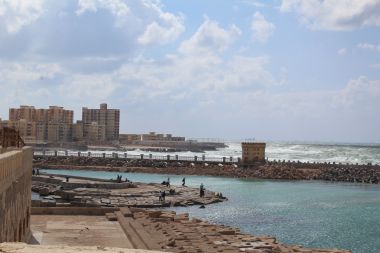
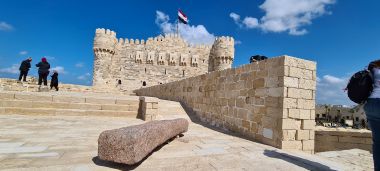
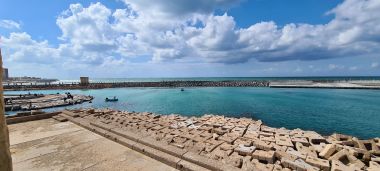
Below us were modern concrete blocks serving as breakwaters. We took our required photographs before heading into the keep itself where we climbed three staircases to the highest level.
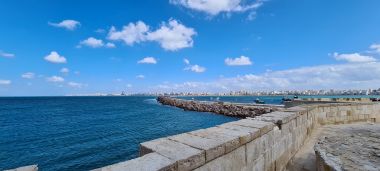
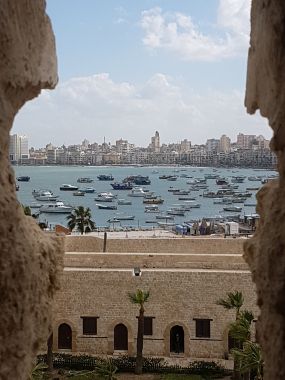
There were lots of largish rooms here but, like everywhere in the citadel, none were furnished nor decorated in any way other than perhaps the window bars and coverings.
It was the glaring bright white building structure itself that is the impressive bit here. There is a nice bit of tile on the ground as you enter the keep but, really, that is the end of it. The staircases, as might be expected, were quite narrow with worn treads that made climbing quite tricky.
Fort Qaitbay Pictures (from Flickr)
Well, at 2:30 pm that was the end of our tour and all that was left was to return to Cairo and another session with Schumacher who did not fail to deliver the racing experience. We managed to record some of it as I am sure you might not believe us…
We stopped again at a road-side service station with an impressive indoor dining area where this time I got a latte for Mel (50 LE).
On the trip back we agreed with our fellow travellers on how much to give as a tip for Ahmed and the driver. Back at the hotel by 5:30 pm Ahmed got Mel's phone number so they could exchange pictures from the trip. We arranged with the hotel to have a breakfast box put together for us as tomorrow we will be leaving very early for the airport, well before the restaurant will open, and settled up our bill from our meal the other day. We had a last visit to the swimming pool at back where we saw the Egyptian football team practicing in the surrounding grassed grounds (evidently no one famous according to the other couple when we sent them the pictures).
Back in our room we sadly packed up for our return to the UK, snacking on the sweet leftovers from our disastrous lunch yesterday and finished off the rest of the drink and food we had in the room.
An interesting, different, but somewhat disappointing day. After the impressive sites we have visited around the country Alexandria pales quite a lot by comparison. I think it was great to visit and see what it was like but I am not entirely sure I would be interested in doing the 2.5 hour drive (each way) to visit again.
Our trip is just about over.
⇒ Continue to Day 12 - Cairo to Nantwich - March 20, 2023
